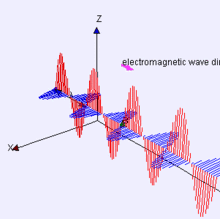Let's say I have a circuit connected to an antenna which listens for a certain frequency range. The antenna would generate an electric current. For an electromagnetic wave we have two main properties- Frequency (or wavelength) and Intensity.
I would like to know what property of EM corresponds to power (electricity). What I mean by this is that does frequency corresponds to voltage (i.e. higher frequency would generate higher voltage) and intensity corresponds to current(i.e. higher intensity would generate higher current), Or the other way around?
The same question for generating EM waves- More voltage would produce higher frequency and more current would produce more intense EM waves or the other way around?
Or am I thinking about it in a wrong way? I guess a different way to ask it would be -in a circuit for detecting EM waves, How would I measure the frequency and how would I measure intensity of that wave? Or while generating EM waves, how would I control the frequency and how would I control the intensity of the wave?
Electrical – Relation between EM frequency/Intensity and voltage/current in a Circuit
antennaradioRFwireless
Related Topic
- Frequency vs. Amplitude modulation in a circuit
- Electronic – Why do we not use both E and B fields for a receiving antenna
- Electronic – How does an antenna tune in a particular frequency on the receiver side
- Electronic – What causes the electromagnetic waves to prefer one dielectric over another
- Electronic – Modulating frequency of a crystal oscillator circuit

Best Answer
In an EM wave, there are actually 3 characteristics (actually there's even more, but they aren't as important here): frequency, electric field strength and magnetic field strength. The "electric" and "magnetic" components of the wave is why it's called an EM ("electromagnetic") wave. the E component can be thought of as related to voltage in a transmission line, and the M component related to the current flowing in that transmission line. The E and M components are related by the characteristic impedence of the medium through which they are travelling. (Interestingly, even a vacuum has a characteristic impedence for RF/MW.) Like electricity flowing in a wire, the power in the wave is proportional to the product of the electric and magnetic field strengths.
So, to get back to your question, in an RF wave, frequency does not correspond to voltage, in general. And both the voltage (electric field) and current (magnetic field) have corresponding intensities.
Just to confuse things and (almost) completely change the topic, there is a fundamental physical relationship known as Planck's equation, and is expressed by the equation E = hν. Here, "ν" is the Greek letter "nu" (not the English "vee", even though in this website's font it looks the same), and represents frequency. "h" is known as Planck's constant, and E is energy. So here it seems like the energy is proportional to frequency. But this relation only holds on an atomic scale for a single "photon" of energy, which is a much, much smaller quanta of energy than anything we measure in electric circuits or communications. So although Planck's equation might look like it's related to your question, and may even be the origin of your "frequency corresponds to voltage" statement, the scale of Planck's phenomenon is far too small for consideration in normal RF and MW applications.